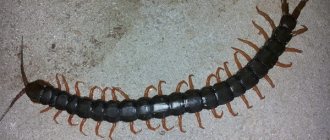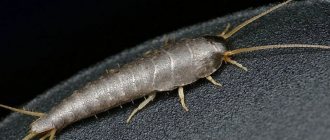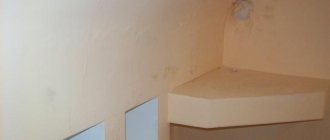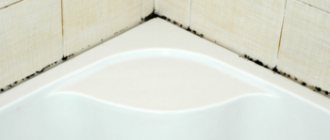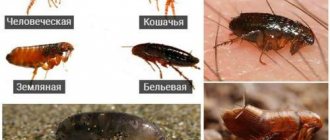Centipedes are a whole superclass of arthropods, which includes more than 16 thousand species, only a tiny part of which is found in the Central region of Russia. When people talk about centipedes in the apartment, often the insects they find have no official relation to this group at all. In everyday life, a centipede is an insect that has many legs or is designed in such a way that it seems like there are many limbs.
You can find out which insects in apartments in Moscow and the Moscow region can be mistaken for centipedes by looking at the photo and studying the key characteristics of each of them. A centipede insect in an apartment is most often one of three creatures: a woodlice, a silverfish or a flycatcher.
Are centipedes harmful to humans?
In fact, apart from its terrifying appearance, the centipede is absolutely safe for apartment residents and for pets and other pets. As a rule, the flycatcher comes out to hunt at night, so many owners do not even suspect the existence of this insect in their home. If you do not try to pick it up (even in this case the flycatcher will not bite a person), then this may not end very pleasantly, since there is poison on the insect’s legs. This can lead to redness of the skin. To get rid of discomfort, just place your hand under a stream of cold water. Pets do not suffer in any way from such a neighborhood. And a person, if he does not do anything unnecessary or unreasonable, cannot suffer either.
Is a centipede bite dangerous?
Cases of arthropods biting humans are extremely rare. When bitten, poisonous saliva is released into the upper layers of the skin; such an amount of poison cannot cause severe harm to a person.
However, itching and redness appear at the site of the bite. In some cases, a red rash may form on the body if a person has an individual sensitivity to the poison.
First aid
If a centipede bites a person, the following measures must be taken:
- wash the affected area with soap and water;
- apply an antibacterial agent (alcohol, cologne) to the bite;
- take anti-allergy medication;
- apply a cold object.
Note! Most often, the pain at the site of the bite goes away on its own after a few hours. Redness can persist for up to two days.
What kind of house centipede is it?
The main thing about a centipede is its exoskeleton, consisting of chitin, a natural polymer, the most common biopolymer on the planet (humans need chitin for the formation of hair and nails, and birds need it for plumage), and sclerotin (a protein). The centipede has a gray-yellow body, with three beautiful purple stripes with a red tint (they may be bluish or have other variations). Exactly the same stripes are found on the numerous legs of the insect. They relate to insects only from a scientific point of view, since they belong to the same type (arthropods). Millipedes have their own superclass and subtype (tracheals).
The flycatcher's body consists of 15 segments that hold the body suspended. The length of the flycatcher's legs increases as it approaches the rear. The last pair may exceed the length of the body. This structure allows the centipede to move quickly and not trip over its legs. Long legs are often confused with whiskers and therefore they cannot determine where the centipede’s head is and where its tail is.
The first pair of legs of the centipede, which lives in the apartment, as a result of evolution, was transformed and turned into a jaw. With their help, the centipede obtains food and defends itself if necessary.
On the head, on each side there are well-developed eyes and there are peculiar “antennae-antennae”, consisting of 500-600 segments. They are like locators, catching the slightest rustle and conducting space exploration. They react sensitively to changes in environmental conditions and temperature, informing them that they need to look for a more comfortable place or settle down here. The antennae warn the centipede of approaching danger.
The centipede has antennae on its head.
Where do they live in nature?
Centipedes are harmless. Living outside:
- under stones and trees;
- in fallen leaves;
- in mulch in the beds.
They breed in damp houses, decaying tree trunks or collapsing wooden beams of buildings and other organic debris. Settling scolopendra at home in the autumn-winter period is fraught with various problems. In human housing, they choose damp places. More often they settle in basements, in rooms on the ground floor or in the bathroom. In winter, centipedes hibernate, finding a warm and secluded place at home. With the arrival of spring, they become active and begin searching for food. Flycatchers are not aggressive, they do not attack people first, and they can only bite in defense. A centipede bite is similar to a bee sting, but the swelling goes away much faster.
Like many other arthropods, fly swatters go through stages of shedding their skin before reaching reproductive maturity. Adults can live up to two years. They usually live outdoors, but sometimes like to live in warm, humid areas where people live.
Centipedes love to hide in garden leaves
Where do they come from?
To fight centipedes and determine the reasons why they appeared in your apartment, you need to carefully examine your home and determine who else lives in it besides you. Centipedes are interested in food and only if there is an abundance of it in your apartment will they be interested in this house. Any small insects in the house can serve as food. They penetrate the house from the external environment, from neighbors. Most often they settle in private houses on the eve of the first autumn frosts, when the search for food forces them to leave the garden, which has become significantly impoverished, and move under the roof. They prefer damp and warm places: basements, ground floors, as well as dark closets in private houses, from where they roam throughout the house in search of food.
Fly swatters also settle in hard-to-reach places. They can enter the apartment:
- from under the concrete slabs lying on the lawn;
- from cracks in hollow walls;
- from boxes with old things;
- from sewage.
It is easiest to see her at home in the dark; in nature they are active during the day.
Centipedes are not gregarious insects, they do not live in colonies; if you see one on the wall of a house or barn and destroy it, you will get rid of this neighborhood.
Highly developed eyes, high speed of movement, and peculiar pincers on the front legs make the centipede an excellent hunter. When moving, the centipede first raises its body on its long legs, freezes for a second, and with one lightning-fast throw moves forward to capture prey.
Another interesting fact is that insects are characterized by a certain level of thinking. Having caught several midges or other insects at once, the centipede eats one and holds the rest with its legs.
The centipede is a good hunter with signs of intelligence
Ways to get rid of centipedes in an apartment
Flycatchers, once in a human home, can live there for quite a long time if there is no shortage of food. To get rid of them, folk, mechanical and chemical methods are used.
Folk remedies for flytrap
Traps with toxic substances should be installed in places inaccessible to children and pets. In this case, to prepare traps the following is used:
- Boric acid is an effective means of combating many insects. Traps should be placed in hard-to-reach places.
- To combat the flytrap, regular, red, but hot pepper is suitable. Before use, the pepper must be ground to a powder.
After grinding, traps are prepared and placed in places where centipedes appear, away from pets and children.
Such control methods can be effective if the number of insects is not large.
Mechanical methods of dealing with centipedes
There are quite simple and affordable methods of control if there are not a large number of insects. For example:
- The insect can be killed with a slipper. But this method is not very pleasant, since you have to remove the results of the actions. In addition, flycatchers move quite quickly and it is not possible to kill them at once. But again, this is not a humane method, especially since these insects are not pests at all, but on the contrary, they can help get rid of pests such as cockroaches.
- The centipede can simply be caught and taken outside the home.
- When a large number of insects and their offspring appear, first of all it is necessary to analyze the reason for such interest of centipedes in the home. After all, they are not interested in human food remains, as well as food supplies. Most likely, somewhere nearby there is a colony of some pests that are included in the diet of centipedes.
- In your garden plot, you need to remove fallen leaves in which centipedes can live. At the same time, you need to make sure that insects cannot get into the house or apartment from the street by sealing all the cracks in the walls, floors, etc.
Chemicals
If there are a large number of insects, it is better to immediately resort to insecticides, since folk remedies may be ineffective. Unfortunately, they cannot be used everywhere and not always. In addition, many prefer exclusively folk methods, as the safest for humans. The following chemicals will help in the fight against flycatchers:
- Aerosol "Raid". This substance is designed to combat crawling and flying insects. Although the drug is considered slightly toxic, after treating the room, it must be well ventilated.
- The insecticide "Combat" also has a quick effect against pests that have grown in the house.
- Aerosol “Clean House”. This product is also designed to combat various types of insects. One bottle will be enough for several treatments, especially against flycatchers, since their numbers are not too large.
Why and how centipedes appear in the house
Any insect can penetrate a person’s home, especially since there are many ways of entry, so it is difficult, and sometimes impossible, to seal all the cracks or cracks that appear from time to time. The insect chooses places with sufficient humidity. Such places can be: bathroom, toilet, basement, storage room, etc. Centipedes love to live in apartments or houses where wooden floors predominate. If the house has parquet floors, then a flycatcher is unlikely to settle in, since they are treated with a special compound that repels insects.
Why you CAN'T kill a FLYTRAP, 10 facts about the flycatcher, or the house centipede
Preventive actions
To prevent a centipede from starting up in an apartment, you need to avoid excessive dampness and remember that the creature will not live in a dry room. To do this, the following preventive measures should be taken:
- systematic cleaning of “wet” rooms: bathroom and shower, thorough dry wiping of pipes and tiles;
- timely sealing of cracks and crevices in windows, on the floor, at the joints of water pipes;
- fighting insects in the house;
- destruction of mold in the apartment;
- Do not allow water to stagnate in the trays of flower pots;
- Periodically you need to ventilate and dry your home.
A centipede encountered in one's own apartment often terrifies people. An insect running quickly seems dangerous and aggressive. In fact, such statements have a basis. The centipede insect is a predator; it is indeed capable of attacking and biting, but not a person, but a fly or moth. She tries to avoid contact with people, hiding in hard-to-reach corners. If there is a clear threat, the centipede may bite; the insect's venom causes problems for people with allergies.
Preventive measures
After getting rid of centipedes, owners need to use prevention methods. Arthropods will not be able to enter the apartment if these conditions are met:
- maintain order in the local area;
- promptly clear the garden of fallen leaves and the vegetable garden of dry grass;
- clean and remove construction waste from the yard;
- remove climbing plants from external walls;
- carefully seal cracks in walls, floors, and window frames;
- strengthen small mesh on ventilation ducts;
- ventilate wet areas well;
- quickly eliminate leaks and condensation;
- fight insects that have entered your home.
It is easy to defeat this creature if you carry out preventive measures in a timely manner.
What to do if you are bitten by a scolopendra
But if you do get bitten by a scolopendra, be prepared for the following consequences (we’ll warn you right away, not fatal). The bites can be very painful and go away slowly over 1-2 days. The main symptoms that you may experience: at the very moment of the bite there will be a sharp and prolonged pain; the severity of the pain can vary (from slight to “10” on a 10-point pain scale); body temperature may increase; you may feel severe weakness; Most likely, the sensitivity of the skin in the bite area will significantly increase, swelling and redness will appear, and loss of sensitivity and a feeling of numbness may also occur.
Scolopendras are somewhat similar to wasps, which do not leave a sting in the wound and can sting a person several times in a row. Often, at the moment of detection by a person, this creature continues to inflict multiple punctures, introducing even more poison. Centipedes usually bite when a person is resting in bed, but they can also crawl into clothes and bite the moment you start getting dressed.
But there is good news: scolopendra bites are not fatal! For a person to die from its poison, he must be bitten by several thousand individuals at the same time!
Helpful advice: if you are bitten by a scolopendra, find a heating pad at home, fill it with moderately hot water (up to 45 degrees C) and apply it to the bite site - this simple measure should bring relief. Scientists have not yet found an explanation for this phenomenon, but they suspect that this is possible due to the fact that some components of scolopendra venom are unstable to heat. The second remedy is ice and analgesics.
Are centipedes dangerous for your home?
And you don’t have to worry about clothes, paper documents, furniture and other items. A centipede is not a moth or a silverfish. She is not at all interested in your things. Another thing is that some centipedes can spoil the air in the house due to the fact that they secrete a bad-smelling secretion - but even that is unlikely - there must be too many of these arthropods in your house for you to smell it. In addition, since centipedes are plant scavengers, they may become interested in rotting wood. We advise you to check attics and basements more often for moisture and for such “yummy things.”
We hope we didn't intimidate you. Therefore, at the end, in order to “whiten up” our heroes a little, let’s tell you how centipedes are useful. They are very active in destroying pests. Their diet includes bedbugs, flies, cockroaches, termites and even spiders. So sometimes centipedes turn into real “guardians of housing” from even more harmful creatures. Therefore, if you are not afraid of such many-legged neighbors, then live with them “in peace and harmony.”
Getting rid of centipedes in the house and apartment
Getting rid of centipedes in a house or apartment is not a difficult task, oddly enough. The main thing is to deprive them of comfortable living conditions. This will increase the chances that the insects will leave the home on their own. In the fight against centipedes, you should adhere to the following recommendations:
- control the humidity in the room (the drier, the less scolopendras will reproduce);
- promptly repair plumbing items if they cause increased humidity in the premises;
- regularly ventilate the bathroom by opening the door or window;
- use ventilation and thermal equipment to dry rooms;
- eliminate mold;
- seal cracks in walls, door and window openings using silicone or sealant;
- install screens on ventilation holes and windows;
- remove insects, as they are food for centipedes;
- clean the area around the house.
All of the above methods can also help prevent these unsightly insects from settling in your home. If flycatchers have bred in large numbers, you can begin more radical methods of combating them.
Folk remedies
Folk remedies are gentle ways to combat scolopendra. An excellent remedy is boric acid. It is necessary to use the substance in the form of a powder or solution, pouring or spreading it around the perimeter. This will scare away the creepy-looking centipede.
If there are not very many flycatchers at home, it is enough to catch them by hand
However, it is important to follow safety measures, since at best the insect will try to escape, and at worst it will defend itself and bite
Purchased chemicals
There are no commercially available chemicals specifically against domestic centipedes. However, you can poison flycatchers with poisons from other insects. Among such means are the following:
- "Medilis-Ziper";
- "Clean house";
- Raid;
- Combat.
Special gels, as well as crayons, for example, “Mashenka”, give a great chance of getting rid of centipedes.
To get rid of centipedes forever and prevent them from returning, you need to take care of cleanliness and order in and around the house. If you omit this simple recommendation, the problem will return again after some time.
Fighting methods
Even though the flycatcher is dangerous to humans, not everyone wants to live next to such a multi-legged insect. The easiest way to remove it is to deprive it of access to food, that is, get rid of all other arthropod pests. Experiencing a lack of food, house flycatchers will leave their homes on their own in search of better conditions.
Mechanical method
The simplest way to get rid of a flytrap is mechanical. The insect can be killed with any hard object (unlike the scolopendra, it does not have a hard protective shell) or caught and then released into the street. Many people prefer the second option, since the centipede is very beneficial for the environment and depriving it of its life is considered a bad omen in many places.
Flycatchers are quite agile and hidden, so catching them is often difficult. It is better to use a transparent container for this - a glass or jar. They cover the uninvited guest from above, put a piece of paper or cardboard under the bottom, after which they take him outside the home and release him into the wild.
If there are a bunch of flycatchers in the house, then to get rid of them you need to understand why they found human habitation so attractive. Usually these insects crawl into the house by accident and do not find a sexual partner there, so they do not reproduce. When a whole flock appears in a living space, then in addition to them there are large colonies of pests in the house - cockroaches, termites, fleas, moths. In this case, you should not rush and poison flycatchers - it is better to direct your efforts to fight the main threat, and the unpleasant neighbors will eventually leave their home due to lack of food.
Folk remedies
If the number of insects is small, they can be scared away from the house using folk remedies. Two methods are used for this:
Boric acid. At the same time, it will repel flycatchers and other insects - almost all of them do not tolerate the effects of this substance. You can buy it at pharmacies or fertilizer stores. It is most convenient to use powdered variations, as they are easier to scatter and clean up. Acid is poured into insect habitats - under sinks, bathtubs, and toilets, in areas behind pipes, near cracks in floors and walls.
It is important to prevent its contact with medications and food products, as well as limit access to children and pets. When the centipedes disappear, it is necessary to carry out a thorough cleaning and wipe all bait areas with a rag with a disinfectant, and then ventilate the room
Red hot pepper. Several pods of this buggy plant need to be very finely chopped, dried and scattered in places where flycatchers run. Like boric acid, this seasoning is destructive to almost all apartment pests, but is not toxic to humans. It is worth clarifying that seasoning from the store will not work - you need a chopped pod, which you can make yourself or buy at the pharmacy.
https://youtube.com/watch?v=msxOAR0J_wo
Chemical removal
If you cannot remove flycatchers using conventional means, you can use insecticides. This is not recommended, since the use of toxic chemicals often causes more harm to humans than proximity to harmless (and even beneficial) flycatchers. Common drugs to combat multi-legged neighbors:
Aerosol "Rapid"
It should be sprayed on the walls in places where flytraps accumulate, paying special attention to crevices and hiding places. Before use, be sure to close windows and doors, and remove all food and medications from the premises.
While working, you should wear gloves and avoid getting the aerosol on your clothes or skin. "Combat MultiSpray". Unlike “Rapid”, it is used with open doors and windows. The spray is used to spray areas where insects accumulate or the surfaces on which they move. Only dry and non-absorbent surfaces can be treated, otherwise the product will lose effectiveness. Aerosol “Clean House”. It is sprayed on the walls, in the cracks and gaps between the baseboards, after which they leave the room for 2-3 hours, removing all people and pets from there and tightly closing the aquariums and terrariums. The second method of application is to spray the entire contents of the can in the center of the room for complete disinfection, but then you will not be able to go there for 2-3 days.
Conventional poisons and baits against flycatchers are ineffective - they prey on living insects, and therefore do not show interest in them. Sticky traps also do not work against them - arthropods disentangle themselves from them or tear off the stuck paw.
The flycatcher is a completely harmless and even useful insect for the home. To prevent it from bothering a person with its unpleasant appearance, it is enough to drive out the pests on which it feeds from the apartment.
Source
Prevention measures
To prevent the occurrence of this type of insect such as a centipede, prevention methods should be followed, which are as follows:
- Normalize the humidity level in the apartment. To do this, check the serviceability of all water pipes and check that the area under the bathtub and toilet is dry.
- After using the bathroom, you must leave the door for ventilation and thoroughly wipe the floor.
- Do not dry things on radiators, and store undried items of clothing.
- Ventilate the apartment regularly.
- Eliminate fungi in the bathroom and other rooms.
- Do not place wet dishes in storage areas.
- Eliminate all insects in the room that could act as food for the flytrap.
- Do not throw wet items into the laundry basket.
- Seal all cracks in the floor and baseboards, especially if the apartment is on the ground floor.
- Have mosquito nets on the windows to prevent insects from entering through the window.
Note! Regular cleaning of the apartment is also of great importance. Particular attention should be paid to hard-to-reach places in the bathroom.
How to get rid of centipedes in an apartment?
The centipedes described above, although different in appearance, are similar in lifestyle. There are 2 types of fight against them:
- chemical - using pesticides;
- technical - this is the drainage of habitats and repair work.
You can combine the two described options for getting rid of these frightening creatures, which will make the house unsuitable for their habitation and drive out those who remain.
Eliminating the source of moisture
If moisture is removed from the room where centipedes are most often found, then these terrible creatures will leave the house. To do this you can do the following:
- repair leaking taps and sewer pipes;
- install water absorption devices;
- install ventilation mesh vents;
- use air conditioners and fans to dry the walls.
Cleaning the room is completed with general cleaning using chlorine-containing products to get rid of centipede for a long time.
In dry air, the centipede's shell will dry out and it will die from dehydration. If you eliminate the microclimate in the house that is attractive to them, they will leave the home in search of a more suitable habitat.
Eliminating access to food
Many house insects are a favorite treat for centipedes. Their food range includes:
All these insects cause harm to people, so they need to be destroyed so that they do not attract flycatchers.
Carrying out repair work
Annual cosmetic repairs to the house will help not only keep it in proper condition, but also clear it of unnecessary “neighbors”. Most often, insects and arthropods enter homes through:
- cracks in the walls,
- open window openings;
- cracks or mouse passages in the floor;
- ventilation ducts shared with neighbors.
To make it difficult for them to enter the premises, you must:
- install mosquito nets on windows;
- seal cracks in the walls and gaps in the floor;
- eliminate mouse passages;
- install ventilation grilles with a fine mesh;
- plaster the junction of sewer and water pipes with walls and floors.
To eliminate cracks, silicone, polyurethane foam, special mastics and putties are used. Their smell drives centipedes out of the house.
It is bad to store old things in your home, which grow mold in damp places and attract insects. Timely repairs will get rid of centipedes that live under peeling wallpaper and in cracks in walls with crumbling plaster. Having made repairs, the owners solve 2 problems: they improve living conditions and get rid of uninvited guests - harmful insects and centipedes.
Use of chemical control agents
Stores do not sell special preparations to kill centipedes. Therefore, some universal drug will do. To eliminate scolopendra in an apartment, you can use the following brands:
- Raid is in the form of an aerosol, which, when used, does not emit an unpleasant odor or substances hazardous to humans.
- Delta zone - does not cause harm to people and animals.
- Medilis-cyper is a highly concentrated drug that is diluted in water. The solution is sprayed on areas where insects or centipedes accumulate. It contains toxic elements for animals and humans, so it cannot be used everywhere.
- Globol Original is a poisonous gel solution that is used to kill various insects.
- Raptor is an aquafumigator that sprays toxic substances into the air. Its use is the most effective compared to other means, but also the most toxic for people, birds, animals and aquarium fish. Therefore, when using it, it is necessary that they are outside the effect of the drug.
- Great Warrior is a product produced in the form of a gel for the destruction of ants, cockroaches, two-wests, and flycatchers.
All these pesticides are made from dangerous toxic substances, so when working with them you need to be careful and take care to reliably protect people, as well as from accidental contact with their eyes or food
Using traps
Scolopendra has one property: if it loses a leg, then after a while a new one grows in its place. Therefore, sticky traps are ineffective for them. She can break free and run away, and after a while she will run along the walls again.
It is better to use barrier protection methods using crayons and gels that will not allow them to enter the house. They are highly toxic and remain effective for a month. This will quickly help get rid of centipedes in a private home.
Traditional recipes against centipedes
Traps can be made using ingredients such as:
- boric acid;
- red hot pepper
Using these means, you can force a scolopendra or flytrap to leave the room. The effectiveness of traditional methods will be maximum only if their numbers are small. It is necessary to place homemade traps in places where centipedes appear and limit access to them for children and animals.
Red pepper
Its pungency will help remove centipedes from the house forever if the product is updated in a timely manner.
You need to sprinkle ground red pepper in places where the flycatcher is often found. It will drive away not only centipedes, but also other unpleasant insects from the house. At the same time, it is worth taking precautions so that pets and children cannot experience the effects of hot pepper on themselves.
Boric acid
Another affordable and effective insecticide against centipedes is boric acid. It is more used by gardeners as a means of combating ants. The drug has a nerve-paralytic effect, but only after prolonged critical accumulation in the body is the drug capable of killing. For example, to kill cockroaches, it will take 8-12 days for them to die, while ants only need a few hours to develop paralysis, which results in death. If such an ant is eaten by its fellows, then the same fate awaits them.
A solution of boric acid is applied using a sprayer to walls, floors and baseboards. You can sprinkle the powder in places where centipedes are found in the apartment. The drug is not toxic, but you can get burned.
Freezing
If you leave your home in extreme cold without heating for several days, the centipedes will die or run away to warm up with neighbors. Freezing is the safest way to eliminate terrible flycatchers and centipedes from your home.
Centipede: description
The centipede got its name due to the fact that it has 15 pairs of legs, quite thin, which reach a length of up to 3 millimeters. The centipede grows up to 60 mm in length. Thanks to this, the insect moves relatively quickly - up to 40 cm per second, which gives it the opportunity to quickly go to cover in cases of danger.
If you carefully examine the insect, you can see small hairs all over the body, and long whiskers grow on the head. Along the entire surface of the body you can find stripes that even extend to the paws. Therefore, the centipede resembles a scary beetle with a flexible, elongated body. A centipede is born with 4 legs, the number of which increases as the insect matures. During her life, a female centipede lays up to 60 eggs.
Centipedes (also called flycatchers) prefer living conditions with high humidity and lack of light. In people's homes, flycatchers choose to live in rooms such as bathrooms, all kinds of closets or basements. As a rule, centipedes appear in human homes before the onset of winter. During this period, the centipede feeds on ants, mosquitoes, flies, cockroaches, termites, spiders, etc. In other words, such a proximity between humans and centipedes is only beneficial for humans.
Those owners who know how the centipede lives and what it eats try to use it as a natural enemy of many insects, sometimes dangerous to humans. The flycatcher can sit motionless for a long time, waiting for its prey, after which it attacks its victim with lightning speed. This is achieved thanks to excellent vision and speed of movement. The flycatcher releases a venom that paralyzes its prey, after which it slowly eats its prey. If she manages to catch two insects at once, then she eats one and holds the other with her paws, since she has many of them.
Flycatchers (centipedes) do not bite humans or domestic animals. They also do not damage room furniture. Therefore, the fight against centipedes is carried out only because many owners do not know how this insect lives and what it eats. A centipede lives for about 7 years. It settles in human housing only to survive the cold. Upon completion, she moves to her natural habitat. When it is very cold, the insect hibernates. It is most active in the spring.
